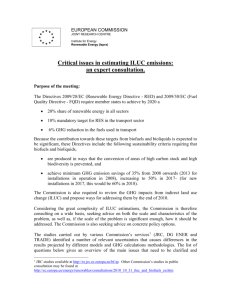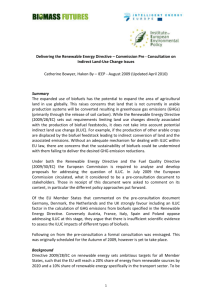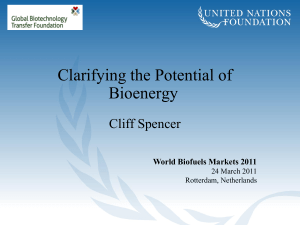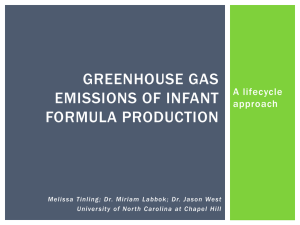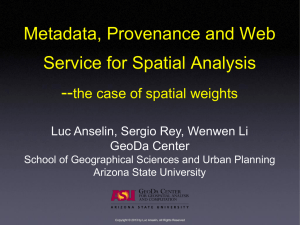P10 Environmental Issues of Biofuels – U. Fritsche
advertisement
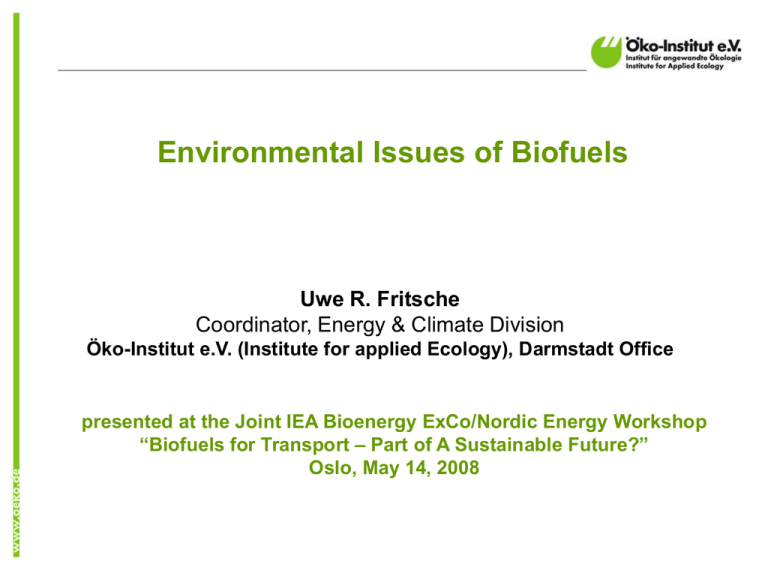
Environmental Issues of Biofuels Uwe R. Fritsche Coordinator, Energy & Climate Division Öko-Institut e.V. (Institute for applied Ecology), Darmstadt Office presented at the Joint IEA Bioenergy ExCo/Nordic Energy Workshop “Biofuels for Transport – Part of A Sustainable Future?” Oslo, May 14, 2008 Öko-Institut Research Divisions Governance & Environmental Law Energy & Climate Industry & Infrastructure Freiburg Office Darmstadt Office Berlin Office Nuclear & Plant Safety Products & Material Flows private, non-profit environmental research, founded in 1977; staff > 100 in 2006; local to global scope of (net)work Sustainable Energy 2000 Global Primary Energy in EJ/year 1800 energy efficiency 1600 EE geoth. 1400 solar wind 1200 1000 solar transition biomass hydro 800 nuclear 600 gas coal bioenergy challenge oil 400 200 0 2000 2010 2020 2030 2040 2050 … 2100 Source: IEA (2007), IPCC (2007), UNPD (2004) and WBGU (2003) 20000 Sustainable Bioenergy transport fuels other 20000 20000 World Energy Outlook 850 Global Bioenergy Potential 18000 0 700 arable land degraded land 16000 14000 residues, wastes 550 Primary Energy Supply in ExaJoule [EJ] Primary Energy Supply in million tonnes oil equivalent [MtOE] pasture land 12000 pasture land 10000 arable land 400 degraded land 8000 residues, wastes 250 6000 4000 low high 100 2000 0 -50 0 2005 2030-REF 2030-AP Source: IEA (2007), and Best et al. (2008) low low high high Environmental Issues • Bioenergy could have positive impacts: – – • GHG reduction (through fossil-fuel substition); more agrobiodiversity; soil carbon increase, less erosion … But impacts could also be negative: – – GHG from cultivation, soil carbon, life-cycle, direct + indirect land-use changes Loss of biodiversity from land-use changes, water use, agrochemicals, erosion… Consider all Bioenergy Flows Biodiversity & Climate Change Source: www.eea.europa.eu Global Biomass Potential Source: IIASA, Kraxner 2007, Rokiyanskiy et al. 2006 Global Biodiversity Source: UNEP IMAPS Global Loss of Forests Source: FAO Global Forest Resources Assessment Endangered Biodiversity Countries with highest number of globally threatened birds Source: Lambertini 2006 Biodiversity & Agriculture Number of Species New agro policies Biodiversity and HNV Farming Examples of HNV farming which could become „extinct“ due to direct or indirect intensification: Dehesas/Montados in Portugal/Spain Source: JRC/EEA 2006 (Proceedings Sust. Bioenergy in the Mediterranean) Land Use and Biodiversity Unused land Used land Areas of high natural conservation value (HNV) Protected area Degraded land and “idle” land Potential for biomass: no competition with food, no displacement, increase organic C in soils, but: risk for biodiversity if not properly mapped Map “key” biodiversity areas Protected Areas (PA) HNCV Areas (not yet PA) - GIS data based on LCCS, update available in March 2008 (FAO, 300 m resolution) - National land cover mapping (high resolution) - Change detection possible for monitoring Global and national land cover maps Screening with criteria PA+HNV areas are “no-go” other areas might be suitable for biomass development, depending of further qualification (water, social issues…) satellite monitoring possible Forests and wetlands Water and Soil • • Water Use of (Bioenergy) Farming Systems – Model and data research ongoing – Spatial data are key, but (yet) unclear Soil Impacts – Mapping of biophysical soil properties – Qualitative Impact Definition (for farming systems/AEZ) – Quantification? More from FAO BIAS Project (mid-2008) Which Standards? Land Use/Biodiversity + GHG reduction have global scope + global conventions “WTO compatible“ EU currently implements these standards in mandatory certification schemes for biofuels Standards: EU • • • • RES + FQ Directive proposals establish mandatory sustainability requirements for production of biofuels Minimum GHG reduction, incl. CO2 from direct land-use change Protection of natural habitats No “relevant” reduction of biological/ecosystem diversity GHG Defaults incl. direct LUC 322 kg CO2-Eq./GJ direct land use change production of biomass 200 kg CO2-eq. per GJ biofuel 180 transport of biomass conversion step I humid savannah transport betw. conv. steps 160 140 tropical rainforest conversion step II transport to admixture fossil reference: gasoline: 85 kg/GJ diesel: 86.2 kg/GJ 120 100 grassland grassland 80 35% reduction 60 40 20 0 wheat corn Ethanol from sugar cane rapeseed oil soy bean oil FAME from palm oil Indirect LUC Forests, wetlands Deforestation, carbon release Protected & other high-nature value areas Food & feed crops Energy crops/ plantations ? Loss of biodiversity „unused“ land (marginal, degraded) Source: based on Girard (GEF-STAP Biofuels Workshop, New Delhi 2005) GHG from indirect LUC • Displacement = generic problem of restricted system boundaries – Accounting problem of partial analysis („just“ biofuels, no explicite modelling of agro + forestry sectors) – All incremental land-uses imply indirect effects • Analytical and political implications – Analysis: which displacement when & where? – Policy: which instruments? Partial certification schemes do not help, but have „spill-over“ effects Indirect GHG: „iLUC Factor“ Accounting for CO2 from indirect land-use change using the “iLUC factor“ (aka “risk adder“) in GHG balances of biofuels* kg CO2eq/GJ with iLUC factor biofuel route, life-cycle Rapeseed to FAME, EU palmoil to FAME, ID soyoil to FAME, Brazil sugarcane to EtOH, Brazil maize to EtOH, USA wheat to EtOH, EU SRC/SG to BtL, EU SRC/SG to BtL, Brazil, tropical SRC/SG to BtL, Brazil, savannah including conversion/by-products, without direct LUC max med min 260 188 117 84 64 45 101 76 51 48 42 36 129 101 72 144 110 77 109 75 42 34 25 17 59 42 25 relative to fossil diesel/gasoline, including conversion/by-products max med min 201% 118% 35% -3% -25% -48% 17% -12% -41% -44% -52% -59% 50% 17% -16% 67% 28% -11% 26% -13% -51% -61% -71% -80% -32% -51% -71% *= By-product allocation using lower heating value; iLUC factor is zero for residues/wastes and for biocrops from unused/degraded lands GHG from LUC: Default vs. real Direct LUC: indirect LUC: A conservative: conversion of savannah indirect LUC: A conservative: conversion trop. rain forest C= B + iLUC factor D: total B real: replacing soy cropping Direct LUC: D: total kg CO2-Eq. per GJ Biofuel 180 D: total land use change A 160 production of biomass BSO Default transport of biomass 140 conversion step I transport betw. conv. steps A 120 conversion step II Practical example (non-default) 100 80 60 transport to admixture C A D B C 20 0 C= B + iLUC factor B real: replacing wheat crops (small reduction of soil C) 200 40 indirect LUC: A conservative: conversion of pasture C =zero iLUC factor B real: conversion of degraded land Direct LUC: B B C EtOH sugarcane D PME Palm oil D RME (rapeseed in EU) Conclusions • GHG emissions become key issue in biofuels trade; certification needed up from 2010 for EU market access; will become linked to CDM • GHG must include (real) direct land-use changes, and GHG from indirect LUC need „risk hedging“ • Methods for verification of GHG from direct LUC need elaboration and harmonization • GHG limits for biofuels also reduce (but not avoid) risk of negative biodiversity impacts; mapping of HNV areas (also in degraded lands) needed • Soil/water restrictions need more attention, but bioenergy also opportunity Conclusions (2) • So far, only few developing countries deal with life-cycle GHG emissions of biofuels, and biodiversity + social issues (BR, MZ…) • Need to actively support countries in dealing with sustainability standards, and certification; role UNEP/GBEP Task Forces • Biogas/biomethane have low GHG profile, but often ignored need more attention Sustainable Biomass Good practice: Agroforestry in Southern Ruanda – food, fiber and fuel from integrated systems More than Jatropha… Source: JRC/EEA 2006 (Proceedings Sust. Bioenergy in the Mediterranean) More Information www.oeko.de/service/bio



